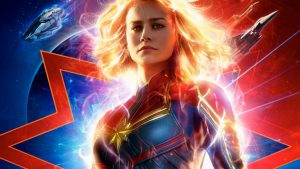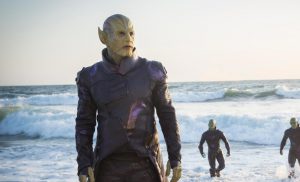Today is Tolkien Reading Day, the best time of year to go out and read up on the works of the great J.R.R Tolkien, author of The Lord of the Rings and The Hobbit. However, if you don’t have access to the books, why not take three hours out of your day to watch one of The Lord of the Rings movies? And since this day is intrinsically linked to things that happened in The Return of the King, Part 3 of The Lord of the Rings trilogy, we’re going to be talking about that film.
Spoilers Ahead!
So let’s start our discussion with a reminder that I am one of those people who read the books first, before seeing the films – but, I am not a book “purist”, someone who believes that everything in the text could have been adapted word-for-word onto the big screen, without any need for changes, additions, omissions, etc.
Now, having watched the film about six-thousand times, I have noticed a number of flaws – little things, for the most part, but we’ll discuss them here: I say “we” because I’m going to be writing this post in Gollum/Sméagol fashion, as an argument between my purist self and my revisionist self. We’ll also discuss a number of scenes that capture perfectly the spirit of the book, and even manage to almost elevate the material (which is so good to begin with).
But, we’ll also talk about the movie in its own right, because it’s just such a good movie. Even if you go into these films never having heard of The Lord of the Rings, or J.R.R Tolkien, you’ll still be swept up into this magical world, and, assuming you’re anything like me, you’ll never leave it again as long as you live. The joy and wonder is still there, every time I open the book or watch one of the movies.
Well, now we’re off at last!
Let’s begin with a breakdown of the plot: the film follows the journeys of a group of Men, Elves, Dwarves and Hobbits as they travel across Middle-earth. Our hobbit protagonist, Frodo Baggins (Elijah Wood), carries with him the deadly but beautiful One Ring, an object of incredible power that contains the very soul of the Dark Lord Sauron. Only by destroying this Ring can Middle-earth be freed from the horrors of war and evil that have been relentlessly assaulting it. The film opens with Frodo and his loyal gardener Sam Gamgee (Sean Astin) being led through the dangerous country around the Dark Lord’s realm of Mordor. Their guide? A treacherous and utterly wretched creature named Gollum (Andy Serkis), who once possessed the One Ring and wants it back. Can he be trusted? Can Frodo be trusted? Can anyone be trusted around the Ring? – for the Ring wants to get back to Sauron, and it has the power to corrupt anyone who owns it. By the time we see Frodo here, in The Return of the King, the Ring has betrayed many masters: it was cut from Sauron’s hand long ago but quickly killed its new owner, a man named Isildur – it fell into the River Anduin, and was there picked up by a hobbit named Deagol, who was very soon murdered by his friend Sméagol. Sméagol took the Ring and fled with it into the mountains, and there, dwelling in dark caves and pits, he changed into Gollum – the Ring abandoned him too, though, and was found by another hobbit named Bilbo Baggins (Ian Holm), but Bilbo was good enough that he was able to give up the Ring willingly – he gave it to Frodo. But the Ring betrayed one of Frodo’s friends as well, the noble man Boromir (Sean Bean), who tried to kill Frodo in an attempt to steal the Ring.
That is, of course, the main plot: the Ring must be destroyed, but destroying it takes great effort and great willpower. And the only place it can be unmade is in the fiery forges beneath an active volcano named Mount Doom, in the very heart of the realm of Mordor. Sauron dwells here, a giant flaming eye atop a horned tower.
Purist’s Note: in the books, Sauron is not a “giant flaming eye”. He has a physical form, but it is terrible and maimed, because he has been unable to take any shape fair to the eyes of Men ever since he fell into the ruin of Numenor in the Second Age. The Eye is merely a metaphor, in the books, for his piercing knowledge of all things that move on Middle-earth.
Thank you, Inner Purist, for making that clear.
Moving on. Many miles away from Frodo, his other friends are busy fighting Sauron’s vast armies of Orcs, Ringwraiths and Haradrim. Aragorn (Viggo Mortensen) is the reluctant King of Gondor who must rally his people to stand in defiance of the shadow. Gandalf the White (Sir Ian McKellen) is the good wizard entrusted with helping all the Free Folk of Middle-earth. Arwen Evenstar (Liv Tyler) is the Elven princess in love with Aragorn, who must choose between an immortal existence with her family, or a mortal life with the man she loves.
But, the fight for victory will not be easy. Sauron has unleashed all of his forces, and they are heading straight for the greatest city in Middle-earth: Minas Tirith, the capital of Gondor. Will Gandalf be able to keep the city’s defenses firm against such reckless hate? Will Aragorn reach the city in time to save it? Will Arwen choose love over the promise of immortality? The stakes are so high, they’re incredible.
Purist’s Note: in the books, Arwen had already chosen love over immortality, many years before the events of The Lord of the Rings. She and Aragorn had been betrothed on the hill of Cerin Amroth, and they had rejected both the Shadow of Sauron and the Twilight of the West.
Yeah, well, that’s not the case here. Here, we have a cast of incredible characters – played by an extraordinary cast – who collide with each other in the most brilliant ways. When the hobbit Merry Brandybuck (Dominic Monaghan) meets Éowyn, shieldmaiden of Rohan (Miranda Otto), will they overcome prejudice to fight in the war for Middle-earth? When Pippin Took (Billy Boyd) swears loyalty to the Steward Denethor (John Noble) will this choice come with a terrible responsibility – to watch as the Steward goes mad and tries to burn his own son alive?
Purist’s Note: well, no, apparently not, because in the movies Denethor releases Pippin from his service – whereas, in the books, Pippin remains in allegiance to Gondor.
This purist is getting on my nerves. You know what, Inner Purist, how about that scene where the Riders of Rohan appear over the hills at dawn and ride down to meet the orcs of Mordor in battle on the Pelennor Fields? Hmm, how about that? Was that not exactly as in the books?
Purist’s Note: well…well, I mean, no, because…
And what about the scene where Gandalf and Pippin discuss the prospect of death, using words directly from the book?
Purist’s Note: okay, that was touching, but the scene itself wasn’t in the books…
How about the scene on Mount Doom? Where Frodo finally stands above the consuming fires, unable to throw the Ring to its destruction? How about when Gollum takes the Ring from him in their last desperate struggle, biting off Frodo’s finger to get the corrupting treasure, dancing madly for joy on the brink of the fire – and falling, to his death? How about that terrifying scene where the Ring sits, motionless, on the surface of the lava, unwilling to be destroyed? And Frodo hangs from the cliff far above, staring down at it, contemplating with himself in those final moments whether he should leap into the fires after the Ring, or if he should take Sam’s hand and be carried to safety? How about that scene?
Purist’s Note: ooh, and how about that tortured look that Frodo gives to Sam as he makes his choice – but then, he reaches for Sam’s hand! And Sam pulls him up! And…uh, I mean, yeah, that scene is fine.
What about the final scene, at the Grey Havens, where Frodo goes off with the Elves to sail across the seas into the West? That emotional goodbye to his friends that has me in tears every time I watch it? That smile he gives as he boards the boat, and you know in your heart that he’s finally going to be healed of all his pain and hurt.
Purist’s Note: and when Sam says “well, I’m back” as he returns to his home, just like in the book…
Well, not just like in the book. If it had been just like in the book, he would have gone home to Bag-end, since in the book he inherited it from Frodo. Also, he should have only had one child at that time, but he had, like, five.
Purist’s Note: well, yeah, but, come on, the emotional heart of Tolkien’s work was all there. Director Peter Jackson could easily have gone for a more traditional route and had them all live happily ever after, but he didn’t. He showed the incredible pain that Frodo went through, and how it could never be healed – unless he left Middle-earth.
Yeah, I know, but Peter Jackson got a lot of things incorrect too. Let’s not forget the infamous scene where Frodo tells Sam to “go home”, which goes against everything in the books. That scene is painful to watch, it’s just so annoying.
Purist’s Note: okay, sure, but don’t forget that that scene was shot really early on, before the actors had any clear idea of the emotional journeys their characters were going on – before Andy Serkis had been cast as Gollum, in fact.
Good point. But how do you explain that scene with the skull avalanche in the Paths of the Dead?
Purist’s Note: wait, I thought you liked that!
I do! But…wait, aren’t you the purist? I feel like things got switched around here. I’m not supposed to be grilling you, it should be the other way round!
Purist’s Note: well, this is pretty normal when dealing with the movies. They’re conflicting, but in the end…they are pretty good movies, even when they’re not great adaptations. And, for the most part, they are great adaptations. Except for…a handful of things.
More than a handful. But, you’re right. No matter how many things might be wrong with the movies, I’m always going to love them. I’m always going to cry when Frodo sets sail into the West, or when Annie Lennox’s beautiful song starts playing over the credits…I’m always going to cheer when Sauron is cast down, and the Eagles rescue Frodo and Sam. I’m always going to feel completely heartbroken after the credits roll, when I realize that the story has finally come to its end. It’s the magic of this movie that makes that possible: you can overlook or even ignore every minor change to a character’s appearance, every faulty line of dialogue, every blunder or misstep. Because the magic is still there.
Purist’s Note: you’re going to tell me what the magic is now, aren’t you?
Yes, I am! It’s the magic of Frodo struggling through pain and torture to do the job that needs doing. It’s the magic of Sam carrying Frodo up Mount Doom, even when all seems lost. It’s the magic of Aragorn going to what seems like certain death so that he can buy Frodo just a little time. It’s the magic of Merry and Éowyn standing up against the Witch-King. It’s the magic of Pippin leaping into the flames to rescue Faramir. It’s the-
Purist’s Note: you’ve gone on long enough. I get it. It’s magic.
It is, and it’s the sort of magic that doesn’t go away, even after multiple viewings.
So there you have it: my thoughts on The Lord of the Rings: The Return of the King. No movie quite compares to it, honestly. It is everything I love about cinema, all rolled into one beautiful movie. From the opening sequence to the moment the screen fades to black, I am entranced, brought into another world, a world that I know and love from the books: not everything from those books made it onto the screen, but that’s okay. This sort of magic is rare. Enjoy it as it is.
Movie Rating: 10/10





